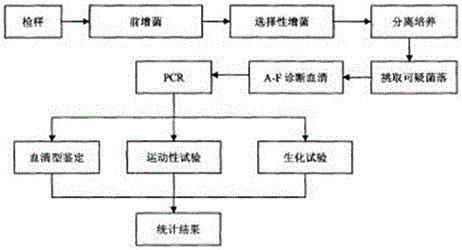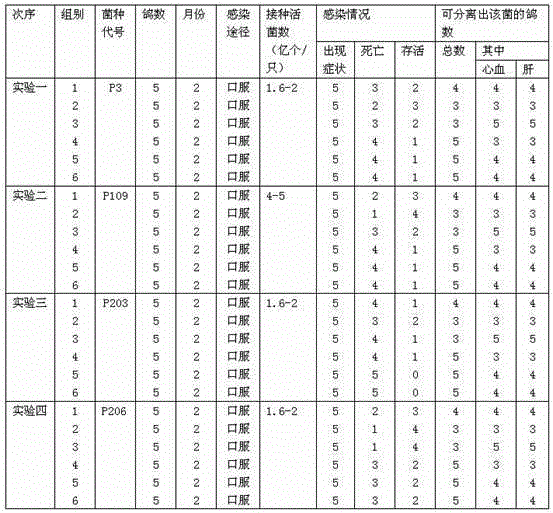Feed additive compound essential oil for preventing diarrhea of pigeons as well as preparation method and application of essential oil
A feed additive, compound essential oil technology, applied in application, animal feed, animal feed and other directions, can solve the problems of unstable chemical composition of essential oil, easy to be destroyed or lost, insufficient stability, etc., and achieve low production cost, easy operation, Reasonable effect of formula
- Summary
- Abstract
- Description
- Claims
- Application Information
AI Technical Summary
Problems solved by technology
Method used
Image
Examples
Embodiment 1
[0019] The principle of the present invention: the essential oil in the formula of the present invention is an antibacterial herbal medicine added to the feed, which has a strong inhibitory effect on the growth of bacteria, yeast and mold.
[0020] The groups are:
[0021] Experimental group 1:
[0022] Artemisia annua oil 0.25g, bitter bean oil 0.5g, thymol 2.5g, humic acid 100g.
[0023] Experimental group 2:
[0024] Artemisia annua oil 1.25g, bitter bean oil 0.8g, thymol 1.25g, humic acid 100g.
[0025] Experimental group 3:
[0026] Artemisia annua oil 2.5g, bitter bean oil 1g, thymol 0.25g, humic acid 100g.
[0027] Control group 1:
[0028] Artemisia annua oil 4g, humic acid 100g.
[0029] Control group 2:
[0030] Bitter bean oil 4g, humic acid 100g.
[0031] Control group 3:
[0032] Thymol 4g, humic acid 100g.
[0033] Specific preparation process:
[0034] Weigh artemisia annua oil, bitter bean oil and thymol according to the weight ratio,...
Embodiment 2
[0036] Drug susceptibility test of Salmonella causing meat pigeons:
[0037] Salmonella (Salmonella) belongs to Enterobacteriaceae, Salmonella genus, is a large group of Gram-negative bacilli that parasitize in human and animal intestines with similar morphology, culture characteristics, reaction and antigenic structure. Salmonellosis is a common zoonotic enteric disease, among bacterial food poisoning around the world, the poisoning cases caused by Salmonella occupy the first or second place. Salmonella has strong vigor and resistance, and is a common and serious threat to pigeons. It is an extremely stubborn bacteria, and it is not easy to completely eradicate it once it is polluted. Salmonella bacteria can be excreted by pigeons' saliva, feces, eggs, etc., and can also infect other pigeons by contaminated feed and drinking water. Salmonella is also very harmful to human health. Infection can cause typhoid fever in humans. Paratyphoid and acute gastroenteritis.
[0038...
Embodiment 3
[0062] Research on the pathogenic characteristics of pigeon salmonellosis:
[0063] Pigeon salmonellosis is also known as pigeon paratyphoid, wing paralysis, leg paralysis and vertigo. Foreign scientific and technological workers have done a lot of research work on the disease and its pathogenic characteristics. The summary is as follows: (1) Salmonella can cause diarrhea, arthritis and motor nerve disorders in young birds. (2) Most of the serotypes of pathogenic bacteria were Salmonella typhimurium var. Copenhagen. This variant is slightly different from the typical Salmonella typhimurium, which lacks bacterial antigens and rarely infects humans. This is the only example of a pigeon specifically infected with paratyphoid. (3) Mostly invade young birds under 1 year old, and the infection rate is usually 10-25%. Old birds that have tolerated it often become carriers and continue to excrete bacteria from their feces. (4) The pathogen of this disease is widely distributed i...
PUM
 Login to View More
Login to View More Abstract
Description
Claims
Application Information
 Login to View More
Login to View More - R&D
- Intellectual Property
- Life Sciences
- Materials
- Tech Scout
- Unparalleled Data Quality
- Higher Quality Content
- 60% Fewer Hallucinations
Browse by: Latest US Patents, China's latest patents, Technical Efficacy Thesaurus, Application Domain, Technology Topic, Popular Technical Reports.
© 2025 PatSnap. All rights reserved.Legal|Privacy policy|Modern Slavery Act Transparency Statement|Sitemap|About US| Contact US: help@patsnap.com



